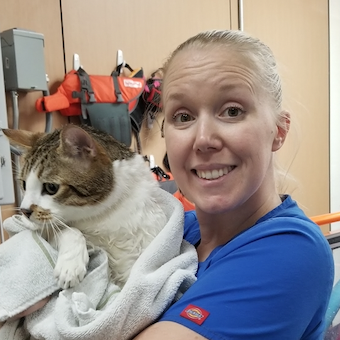Both the Veterinarian’s Oath and the Veterinary Technician’s Oath (which Galaxy Vets has launched a petition to evolve) emphasize the importance of learning and growth.
“I accept as a lifelong obligation the continual improvement of my professional knowledge and competence."
- The Veterinarian's Oath
“I accept my obligations to practice my profession conscientiously and with sensitivity, adhering to the profession’s Code of Ethics, and furthering my knowledge and competence through a commitment to lifelong learning.”
- The Veterinary Technician Oath
We must be humble, vulnerable, and eager to continuously learn and grow both individually and as a collective profession.
Debbie Boone, President of VetPartners tells us, “when practices make accessibility to education easy by having learning tools available and encouraging and rewarding team members to learn, lots of good things happen.”
So, how can we embrace learning and growth better in practice?
3 Ways to Embrace a Life of Learning & Growth in Veterinary Practices
1. Invest in your peoples’ education (& yours!)
“As a leader in the veterinary continuing education sector,” notes Adam Christman, CVO at dvm360, “I have found learners do best when they are immersed as participants, not spectators, and when the speaker is a facilitator, not a lecturer.”
“Learners are more likely to exchange open dialogue and even network better. We are finding an incredible amount of collaboration happening within our profession for education — veterinary technicians and veterinarians are facilitating discussions, TOGETHER.”
Learning is a life-long process. By checking ego at the door, we can all be beginners together. Whether that’s as a long-tenured veterinarian or a day-one receptionist.
2. Set goals.
Alyssa Mages, CVO at Empowering Veterinary Teams, explains how we can do this well.
“Do this for the leadership & all team members. Revisit them – at least bi-annually, and make sure they’re not just SMART but SMARTER; we’ve all got to be able to evolve & readjust. Hold each other accountable in this — top-up & bottom-down.”
SMARTER here referring to:
- Specific
- Measurable
- Attainable
- Realistic
- Timely
- Evaluated
- Reviewed
Creating goals with this framework ensures you’re working towards something clearly defined and trackable.
3. Make learning the norm in your practice
Employers who provide continuous training have 218% higher income per employee than those with less comprehensive training.
“These types of businesses run like a Ferrari,” Debbie remarks. “They also drive enough revenue to reward the team members with appropriate living wages, benefits, and promotions.”
“Practices who are committed to growing their teams make definite commitments to team training. They set aside time at least once a month to provide education. They also reward growth and knowledge with pay increases and opportunities to move up in the organization.”
Want to explore more practical tips?
Check out the section on upskilling and mentoring in The Ultimate Guide for Awesome Culture in Veterinary Medicine.
Want to share some of your favorite practical tips?
Collaborate on an article with us! (Email sara@hound.vet for details.)
From the Experts
From Debbie Boone, President @ VetPartners:
For many years I wrote a column called Culture Coach. In my articles, I discussed the importance of building a culture so comfortable and uplifting that people looked forward to coming to work.
Often we think about positive culture as everyone “being nice” but it goes far beyond that. Because even in good cultures people have bad days. It is just that in good cultures people are listened to, understood and given “grace” as we say in the South. That means we assume positive intent rather than harmful intent.
How do you grow a culture like this? The answer is education. We must train our teams on subjects beyond medical care. They must learn the most important lessons of all...how people think and how they think. Once leaders began to share the knowledge of “being human” then the team can put aside petty bickering, bullying, and gaslighting and develop a group hungry for knowledge. I recently read an article about habit.
Do you know you are more likely to go to the gym if it is less than 4 miles from your home? I am more likely to take a daily walk if I immediately put on my tennis shoes in the morning. When practices make accessibility to education easy by having learning tools available and encouraging and rewarding team members to learn, lots of good things happen.
Well trained people are confident and it shows. Clients say “yes” more often and income grows. People who feel invested in and encouraged to grow, stay. People who stay become deeply familiar with workflows, clients, patients and each other creating a well-oiled machine that anticipates needs and fulfills them, often without a word being spoken.
These types of businesses run like a Ferrari. They also drive enough revenue to reward the team members with appropriate living wages, benefits and promotions. Practices who are committed to growing their teams make definite commitments to team training. They set aside time at least once a month to provide education. They also reward growth and knowledge with pay increases and opportunities to move up in the organization.
Life in veterinary medicine does not have to be as difficult as we sometimes make it. When we work in a great culture with well-trained, well-paid people who have gained emotional intelligence through focused education on the topic, we don’t have drama, we greatly reduce angry clients and avoid a poor preforming practice. When we invest in growth and education it is fun to go to work and fulfilling to care for our patients. It is an investment in wellbeing for our team and our patients. Knowledge is empowering and confidence is convincing.
Invest and watch what happens.
<3 an obsessed lifetime learner
From Adam Christman, CVO @ dvm360:
Learning is a lifelong journey empowering colleagues to aspire higher both professionally and personally.
As a leader in the veterinary continuing education sector, I have found learners do best when they are immersed as participants, not spectators, and when the speaker is a facilitator, not a lecturer. Learners are more likely to exchange open dialogue and even network better. We are finding an incredible amount of collaboration happening within our profession for education---veterinary technicians and veterinarians are facilitating discussions, TOGETHER.
Multi-disciplinary discussions among veterinary specialists are providing tools and skillsets to all veterinary professionals more so than ever. This is the power of advancing our culture! We are becoming the true storytellers of our profession, creating a narrative for future generations to appreciate the importance of collective learning, across all disciplines and all veterinary professional roles. This is veterinary medicine!
From Alyssa Mages, CVO @ Empowering Veterinary Teams:
The marketing gurus for Nike answered this very well. Just. Do. It.
Ideally it would be this simple. In reality we all know that it isn’t. And that’s where we come in. Who? ALL of us in this incredible profession. Granted, there are those of us that are better poised to bring this about, through the connections we have, and the work we do outside of the hospitals. Now we need to band together and raise our collective voices so no one can even pretend not to hear us.
And what exactly are we going to say? What are we going to do? We’re going to bring to light – continually, cuz this isn’t the 1st time, nor will it be the last – the hard numbers of what happens when we neglect (and that’s a harsh word for us in vet med, as we battle against that term daily on behalf of our patients) to support & grow our teams. We’re so focused on getting people into our profession, we’re missing those that have been here that are now leaving in droves. We’ve got to recalibrate our approach and home in on the retention of the rockstars that are already here.
Below are some stats to back this up:
- The average cost of replacing (recruitment, hiring, training) one (1) employee is equivalent to their annual salary when factoring in their hourly wage, the manager’s & trainer(s) hourly wages, materials, resources, etc.
- Monotony, underutilization of skills & lack of opportunities lead to burnout in a much higher rate in veterinary technicians, and even higher in women in this role in practice.
- Via ANOVA analysis (scale from 0-4), vet techs were at 2.7
- The average cost of retaining an employee tends to break even when factoring in the benefits (productivity, engagement, profitability) and weighing against the cost of recruitment.
- There is a distinct lack of diversity in our profession. 89.1% of veterinarians are White (Non-Hispanic), 4.23% identify as Asian (Non-Hispanic), 2.25% identify with two (2) or more races (Non-Hispanic), and 1.7% identify as Black.
These numbers do not reflect the ethnic identities of the support team members (CSRs, VAs, VT/VNs), but data suggests that they are very similar.
When each practice focuses on the existing culture & how to improve it, guess what happens?
Team members stay. They’re more engaged – with each other & the overall practice’s mission. Productivity increases leading to an increase in, you guessed it, revenue. This cultural shift cannot be transient nor superficial, but a true investment in the heartbeat of the practice – the team, the ENTIRE team. CSRs, VAs, VT/VNs, DVMs/VMDs, management & anyone else who walks through those doors to keep the place running.
What improvements need to be made? It depends! Here are a few suggestions:
Wellbeing & clinical skills training should not be made mutually exclusive.
Invest in both. For when our technical acumen degrades, our mental health & overall wellbeing takes a hit. The opposite is also true. If we’re not supported whole-istically, our clinical skills won’t be as sharp as they need to be. These skills trainings & support should be instituted as an integral pillar in every practice, not as an optional or secondary thought.
Work to live, don’t live to work.
Understand that stuff happens, and respect that for everyone. No more guilt trips for taking a personal day – they’re sacrosanct. Stick to a set number of hours worked. On-call? Elective not mandatory. Boundaries between work & home should be set and adhered to. Oh, and more than just livable wages please.
Ensure there are ongoing learning/growth opportunities.
Life isn’t going to stop teaching us, so we better not stop learning. Set goals! Do this for the leadership & all team members. Revisit them – at least bi-annually, and make sure they’re not just SMART but SMARTER; we’ve all got to be able to evolve & readjust. Hold each other accountable in this – top up & bottom down.
Invest in the Future of Humanity
Yes, we’re in this profession because we love animals. However, we work with humans & our patients cannot drive themselves to the hospital. This means we have to enact & uphold the principles of equity, inclusion & diversity. Not for the optics. Certainly not to be performative. To really & truly show up, speak out, and ensure that everyone is welcome and safe in veterinary medicine.
- Do the work – allyship is not a noun
- Do the research – don’t be unfounded
- Outsource & give credit – call in the experts & make sure they’re recognized
- Continually evolve – medicine isn’t static nor is humanity (Ensure your mission, vision & values reflect this)
- Own the mistakes – apologize & do better
Follow Through
If we’re gonna say we’re doing something, we darn well better do it. Practice what we preach and all that, right? It’s all well and good to make a blanket statement of support, but it’s not worth anything without actions to back it up.
It’s pretty clear that in order to thrive in this world - regardless of the profession we’re in – we must ensure that we are continually pushing ourselves to learn & grow. Life is dynamic, we are not static beings, and it is high time that this became a universal sentiment. C’mon Vet Med - let’s do this.







.gif)


